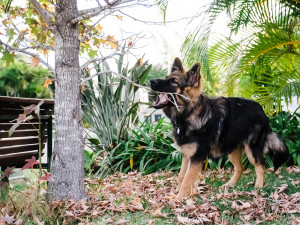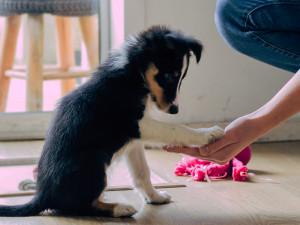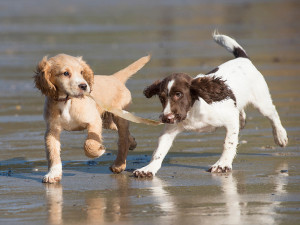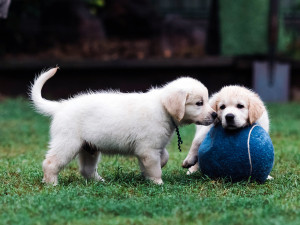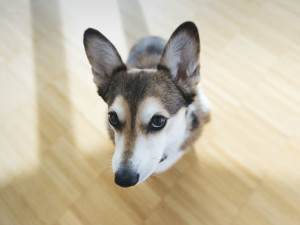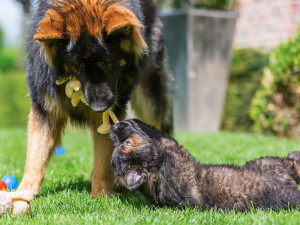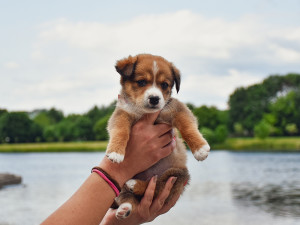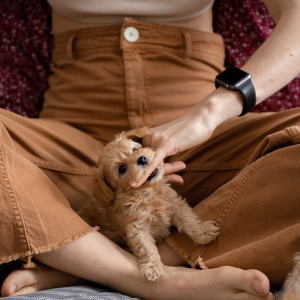Puppy Fear Periods: Why is My Dog Scared All of a Sudden?
Turns out, adolescence isn’t just tough for humans—it can be hard on dogs, too.
In their development, puppies go through at least two phases where they are particularly fearful, even if they haven’t previously shown signs of being scared. These are called “fear periods.” These fear periods in dogs can take pet parents off guard if they don’t know about them. If they are expecting to see fear stages in dogs, it’s easier for both the people and the dogs to handle them and move past them in a way that is most beneficial to their dogs.
Knowing that puppy fear periods are a normal part of development makes it easier to cope when your dog is suddenly scared of things that didn’t used to bother them.
What are puppy fear periods?
Puppy fear periods are normal developmental stages. At this time, young dogs are more fearful than they are before or after these stages. Fear periods are predictable stages in puppy development during which dogs are more likely to react to people or objects in a way that tells us they are scared.
The triggers may be new things, as puppies are often more afraid of new things during fear periods than they are either before or after these fear periods. Puppies may also react to objects or people that never used to stress them out, like a trash can on the side of the road, a door slamming, or a person shoveling snow.
How much do you spend on your pet per year?
Why do puppies have fear periods?
Puppies have fear periods because it is advantageous for them to be cautious at certain times during their development. There are many causes of fearfulness in dogs, and lots of reasons dogs are cautious or afraid of all kinds of things. Many of the causes of fearfulness in dogs affect dogs’ development and their adult behavior.
If dogs have had insufficient socialization, a traumatic experience or multiple traumatic experiences, or they are genetically predisposed to fearfulness, they will need help to overcome their fears. Even if they improve a lot, they are unlikely to be as happy-go-lucky or confident as dogs whose lives were never touched by such challenges.
Fear periods are different because most dogs go through them and emerge from them without lingering fears being carried into adulthood. Puppies are more fearful and cautious at certain predictable times in their development. These milestones are associated with change in the puppy’s life when being cautious helps keep them safe.
The first puppy fear period happens around the time that puppies leave their litter and their mother and begin their life in a new home. With exposure to an entirely new environment with potential unknown dangers and without their mom there to guide and protect them, a little extra caution benefits them. Similarly, the second puppy fear period happens during a time when adolescents are becoming more independent — faster and stronger, too. A little extra concern about the world, manifested as fearfulness, likely prevents them from dangers.
At what ages do puppies have fear periods?
The first fear period in puppies happens when puppies are about eight to 11 weeks old (roughly two to three months in age). The second fear period occurs when dogs are in the range of six to 14 months old. This second fear period in puppies is associated with adolescence and has been called “juvenile onset shyness” by famous behaviorist and dog trainer Patricia B. McConnell, PhD. This fear stage in adolescent dogs is often more surprising to people because they have usually been living with their dog for longer and aren’t accustomed to them being fearful.
Seeing their dog change in a manner that has them acting differently, especially when they behave less confidently than before leaves many people asking with shock, “Why is my dog anxious all of a sudden?” But both the first fear period in dogs and the second fear period in dogs are well-known fear periods that occur at predictable ages.
How long do puppy fear periods last?
Puppy fear periods usually last just a few weeks, though lasting over a month is not unusual. It’s typical for puppies in fear periods to react to things they didn’t used to care about, like trash cans on the side of the road, a skateboarder going by, or the sound of the blender when you make your morning smoothie, but still be chill about many of the ordinary events and objects they encounter in their daily life.
If the puppy is scared of everything or the fears last for many months, what’s going on may not be a fear period. The situation may be a dog who is more generally anxious or fearful. These dogs may need more help overcoming their fears than typical dogs who are experiencing the typical fear stage in adolescent dogs or in puppies.
What does a fearful dog look like?
Fear-based behavior can vary widely — from cowering under the table when a truck roars by to lunging at, and even biting, visitors. Many dogs whine, bark, or make other distress sounds. People don’t always recognize these actions as fearful behavior. Other signs of fearfulness in dogs are telltale body postures and visual signals including:
Crouching in a lowered body position
Lying down and freezing
Tension in body or face
Mouth closed shut tightly
Panting
Yawning
Tongue flicking
Pulling back the corners of their mouth
Dilated pupils
Actively avoiding looking at something
Showing a half moon shape of the white of their eye (called “whale eye”)
Putting their ears back
Tucking their tail
How to help you puppy when they become fearful
When your dog is spooked by something, follow these general guidelines. Getting out of the scary situation is an important part of helping them overcome their fears, but there are other tips to overcome fearfulness when puppies are going through a fear period.
Talk in a relaxed, cheerful way to your dog, perhaps saying, “Yes, that’s a really loud truck, isn’t it? Oh, look, there it goes down the road.” Obviously, your dog won’t know what you are saying, but your normal conversational tone of voice can help your dog calm down.
If your dog wants to be near you, feel free to pet or play with them. You want them to come to you when they need to feel more secure. There is no need to worry that you are reinforcing your dog’s fears. You are just providing comfort, as you should.
Don’t panic or react dramatically. If your dog is out of control, it is all the more critical that you stay relaxed. Try to control your own startled response to your dog’s barking or lunging, if possible.
Don’t force your dog to approach something they fear. Doing so will just make them more scared, which is counterproductive. If your dog wants to get away from a ladder or a man shoveling snow, that’s fine. Sometimes, the best thing you can do is minimize their exposure to something overwhelming, even if that means turning and heading the other way. Just calmly turn and move away from what is scaring your dog so that they don’t get any more worked up. If your dog can count on you to get them out of situations that scare them, that is good for their confidence and builds their trust in you.
Give your dog something they love whenever they get nervous. So, if your dog suddenly widens their eyes and looks nervous when they see a new person, try to have as many new people as you can toss them a treat when they are far enough away that your dog is OK with them. If traffic cones set your dog off, give them a treat or pull out a tug toy every time you see one. It’s important that it’s something the dog loves. The more you can teach them that things that spook them predict good things, the easier it will be for them to overcome their adolescent fears.
If your adolescent dog suddenly seems a little skittish but has previously been confident, it is likely that your dog is just entering a normal developmental fear period during which new things (and even not-so-new things) scare them. It’s so useful to know this stage is temporary and completely normal.
Within a few weeks or a month, your dog is likely to be just as social and happy about whatever the world brings their way as they were when they were a puppy. If your puppy always found the world to be a scary place, they will most likely continue to be cautious or fearfulopens in new tab as an adult, but they may be even more so in adolescence.




